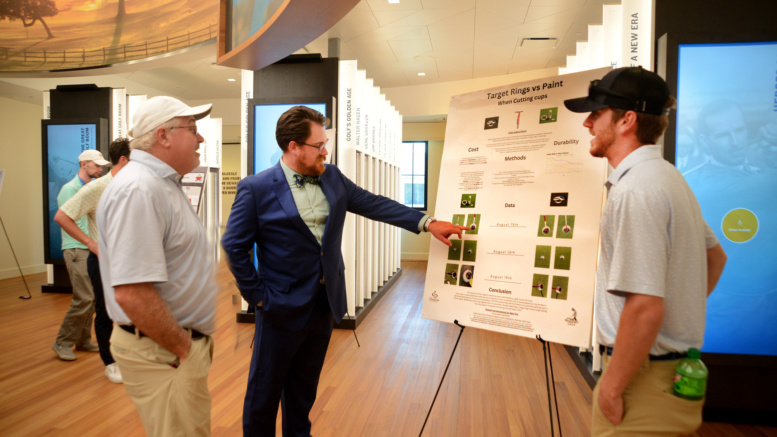By Jonathan Bym
Staff Writer
The current cohort in the U.S. Golf Association Greenkeeper Apprenticeship Program was charged with visually bringing to life parts of their jobs through research presentations that most don’t realize about the golf industry.
Through brightly presented charts and photos, the research topics varied from explaining grass-growing methods, sprinkler upgrades, the battle against nematodes, and the reasoning for other best practices in golf course maintenance that the layman might not understand.
GAP students, who meet regularly at Sandhills Community College as part of the innovative program in its second year, recently welcomed the conversations from the public by using their posters to detail their quantifiable data at an event at the World Golf Hall of Fame.
“I think a lot of them made huge strides. Not only were they doing the data collection and learning how to collect data and what the scientific process really looks like, but then also, ‘How do I share this story by taking the data and making it something for lay people to understand?’” GAP coordinator Carson Letot said. “That exercise is really important. They will never forget this stuff.”
The 13 posters presented were used to reinforce the curriculum that bolsters the understanding of the work done on the golf course, and also to give the one-year students a taste of the scientific method in a comfortable setting. Instead of presenting a project to a lecture hall, the more intimate setting allowed for more one-on-one interaction with maintenance professionals and the public alike.
“These folks are college students, so they most certainly should not be people who are excluded from the scientific process to be able make scientific discoveries,” Letot said. “You’re not only learning a little bit more about your own work to be able to describe it, but people are engaging with you and talking about the great things they see, and the things you might not have thought of.”
For Brandon Cox, his research on nematode population underneath putting surfaces based on weather conditions at the Dormie Club was more than just a project. He started the research when Eric Harbauer, Dormie Club’s director of agronomy, piqued his interest on the subject.
“He’s just as into it as I am. He’s big into this study, as much as I am. We’re thinking about continuing it for another year or so to see where our numbers take us,” Cox said. “I was really into it, and using scientific study. I could see myself doing a lot of these in the future. It embeds the information in your mind.”
Cox, who has 10 years of experience across several courses in the area, has used this experience to network with representatives of different aspects of the golf course maintenance, and pest management side, of his job. He sees where his findings could help out other golf courses in the Sandhills with the same pest problem.
“I knew they were a problem at our golf course, and that was about it. Now I’m getting pretty close to being an expert,” Cox said with a laugh.
Letot said that superintendents from several local courses came to interact, question and take ideas back to their course, for a more “tightly woven” community.
“All these different things that these students come in contact with on a daily basis as part of their job that they just do, and now they are thinking about what they can do to do it better,” Letot said. “A lot of times it takes scientific work to leverage those critical decisions to change those practices.”
This is a new wrinkle in the GAP syllabus this year. While it has taken the students out of their comfort zone, it has also shown them different ways to approach their jobs.
“I thought it was going to be more learning the trade than doing some of this,” said Aaron Chastain, who works at Tobacco Road Golf Club. “This has definitely opened my eyes to what goes on at a golf course.”
Chastain said this program has bridged the gap in his profession, being able to take the class for free and learn how to be more effective working on the course. He added he felt like a scientist during the data gathering portion of the project, plotting the moisture patterns of wetting agents usage on putting surfaces on the 17th hole at his home course.
The promotions and ladder-climbing from GAP students continued from the first cohort to now. Cox has already been promoted after more than seven months working at Dormie Club to assistant superintendent in training.
“This program here opened my mind a lot to the industry,” Cox said. “Who knows where it’s going to take me? We’ll see.”
Contact Jonathan Bym at (910) 693-2470 or jonathan@thepilot.com.
xBy Jonathan Bym
Staff Writer
The current cohort in the U.S. Golf Association Greenkeeper Apprenticeship Program was charged with visually bringing to life parts of their jobs through research presentations that most don’t realize about the golf industry.
Through brightly presented charts and photos, the research topics varied from explaining grass-growing methods, sprinkler upgrades, the battle against nematodes, and the reasoning for other best practices in golf course maintenance that the layman might not understand.
GAP students, who meet regularly at Sandhills Community College as part of the innovative program in its second year, recently welcomed the conversations from the public by using their posters to detail their quantifiable data at an event at the World Golf Hall of Fame.
“I think a lot of them made huge strides. Not only were they doing the data collection and learning how to collect data and what the scientific process really looks like, but then also, ‘How do I share this story by taking the data and making it something for lay people to understand?’” GAP coordinator Carson Letot said. “That exercise is really important. They will never forget this stuff.”
The 13 posters presented were used to reinforce the curriculum that bolsters the understanding of the work done on the golf course, and also to give the one-year students a taste of the scientific method in a comfortable setting. Instead of presenting a project to a lecture hall, the more intimate setting allowed for more one-on-one interaction with maintenance professionals and the public alike.
“These folks are college students, so they most certainly should not be people who are excluded from the scientific process to be able make scientific discoveries,” Letot said. “You’re not only learning a little bit more about your own work to be able to describe it, but people are engaging with you and talking about the great things they see, and the things you might not have thought of.”
For Brandon Cox, his research on nematode population underneath putting surfaces based on weather conditions at the Dormie Club was more than just a project. He started the research when Eric Harbauer, Dormie Club’s director of agronomy, piqued his interest on the subject.
“He’s just as into it as I am. He’s big into this study, as much as I am. We’re thinking about continuing it for another year or so to see where our numbers take us,” Cox said. “I was really into it, and using scientific study. I could see myself doing a lot of these in the future. It embeds the information in your mind.”
Cox, who has 10 years of experience across several courses in the area, has used this experience to network with representatives of different aspects of the golf course maintenance, and pest management side, of his job. He sees where his findings could help out other golf courses in the Sandhills with the same pest problem.
“I knew they were a problem at our golf course, and that was about it. Now I’m getting pretty close to being an expert,” Cox said with a laugh.
Letot said that superintendents from several local courses came to interact, question and take ideas back to their course, for a more “tightly woven” community.
“All these different things that these students come in contact with on a daily basis as part of their job that they just do, and now they are thinking about what they can do to do it better,” Letot said. “A lot of times it takes scientific work to leverage those critical decisions to change those practices.”
This is a new wrinkle in the GAP syllabus this year. While it has taken the students out of their comfort zone, it has also shown them different ways to approach their jobs.
“I thought it was going to be more learning the trade than doing some of this,” said Aaron Chastain, who works at Tobacco Road Golf Club. “This has definitely opened my eyes to what goes on at a golf course.”
Chastain said this program has bridged the gap in his profession, being able to take the class for free and learn how to be more effective working on the course. He added he felt like a scientist during the data gathering portion of the project, plotting the moisture patterns of wetting agents usage on putting surfaces on the 17th hole at his home course.
The promotions and ladder-climbing from GAP students continued from the first cohort to now. Cox has already been promoted after more than seven months working at Dormie Club to assistant superintendent in training.
“This program here opened my mind a lot to the industry,” Cox said. “Who knows where it’s going to take me? We’ll see.”
Contact Jonathan Bym at (910) 693-2470 or jonathan@thepilot.com.







